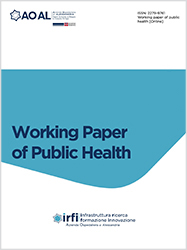Evaluating the effectiveness of rehabilitation and behavioral therapy for fecal incontinence and soiling in pediatric patients with rare congenital MAR and HSCR: study protocol and preliminary results

Accepted: 6 September 2023
All claims expressed in this article are solely those of the authors and do not necessarily represent those of their affiliated organizations, or those of the publisher, the editors and the reviewers. Any product that may be evaluated in this article or claim that may be made by its manufacturer is not guaranteed or endorsed by the publisher.
Background and Aims: to evaluate the effectiveness of rehabilitation combined with behavioral therapy for fecal incontinence and soiling in children with rare congenital MAR and HSCR disorders. Materials and Methods: single-centre prospective interventional study with assessment of soiling and fecal incontinence outcomes using rating scales (Wexner Scale, Rintala Scale) at T0 (before treatment), T1 (at the end of treatment), and T2 (12 months later). Results: the collection of data is currently still ongoing, statistical analysis has started on the subset of results associated with enrolment between January 2021 and December 2021. To date, 15 patients have been enrolled, and an initial analysis has shown improvements in scale scores. Conclusions: the results to date demonstrate the efficacy of rehabilitation combined with behavioral therapy in the management of fecal incontinence and soiling in pediatric patients with MAR and HSCR.
Wood RJ, Levitt MA. Anorectal Malformations. Clin Colon Rectal Surg. 2018;31:61-70. DOI: https://doi.org/10.1055/s-0037-1609020
Mundt E, Bates MD. Genetics of Hirschsprung disease and anorectal malformations. Semin Pediatr Surg. 2010;19:107-17. DOI: https://doi.org/10.1053/j.sempedsurg.2009.11.015
Le MAR - cenni di embriologia. Available from: https://www.aimar.eu/le-mar/
Martucciello G. Regressione caudale e malformazioni anorettali - tecnica chirurgica. 2012. Available from: www.chirurgiapediatrica.eu
Le MAR – la prognosi funzionale. Available from: www.aimar.eu
Wetherill C, Sutcliffe J. Hirschsprung disease and anorectal malformation. Early Hum Dev. 2014;90:927-32. DOI: https://doi.org/10.1016/j.earlhumdev.2014.09.016
Chhabra, K. Hirschsprung’s disease. Pediatric Surgery. 2016;34:628-32. DOI: https://doi.org/10.1016/j.mpsur.2016.10.002
Butler Tjaden NE, Trainor PA. The developmental etiology and pathogenesis of Hirschsprung disease. Transl Res. 2013;162:1-15. DOI: https://doi.org/10.1016/j.trsl.2013.03.001
Moore SW. Advances in understanding the association between Down syndrome and Hirschsprung disease (DS–HSCR). Pediatr Surg Int. 2018;34:1127-37. DOI: https://doi.org/10.1007/s00383-018-4344-z
Bortolami A. Riabilitazione del pavimento pelvico. Elsevier, Amsterdam, The Netherlands. 2009. 320 pp.
Rossetti P, Travan T, Favaro F, et al. Patologie colorettali e riabilitazione. Società Italiana Urodinamica. 2003.
Paquette IM, Varma MG, Kaiser AM, et al. The American Society of Colon and Rectal Surgeons’ Clinical Practice Guideline for the Treatment of Fecal Incontinence. Dis Colon Rectum. 2015;58:623-36. DOI: https://doi.org/10.1097/DCR.0000000000000397
Copyright (c) 2024 Enrica Cantone, Roberta Di Matteo, Silvia Camillo, Rossella Raffo, Elena Grassi, Tatiana Bolgeo, Antonio Maconi

This work is licensed under a Creative Commons Attribution-NonCommercial 4.0 International License.
PAGEPress has chosen to apply the Creative Commons Attribution NonCommercial 4.0 International License (CC BY-NC 4.0) to all manuscripts to be published.

 https://doi.org/10.4081/wpph.2023.9772
https://doi.org/10.4081/wpph.2023.9772




